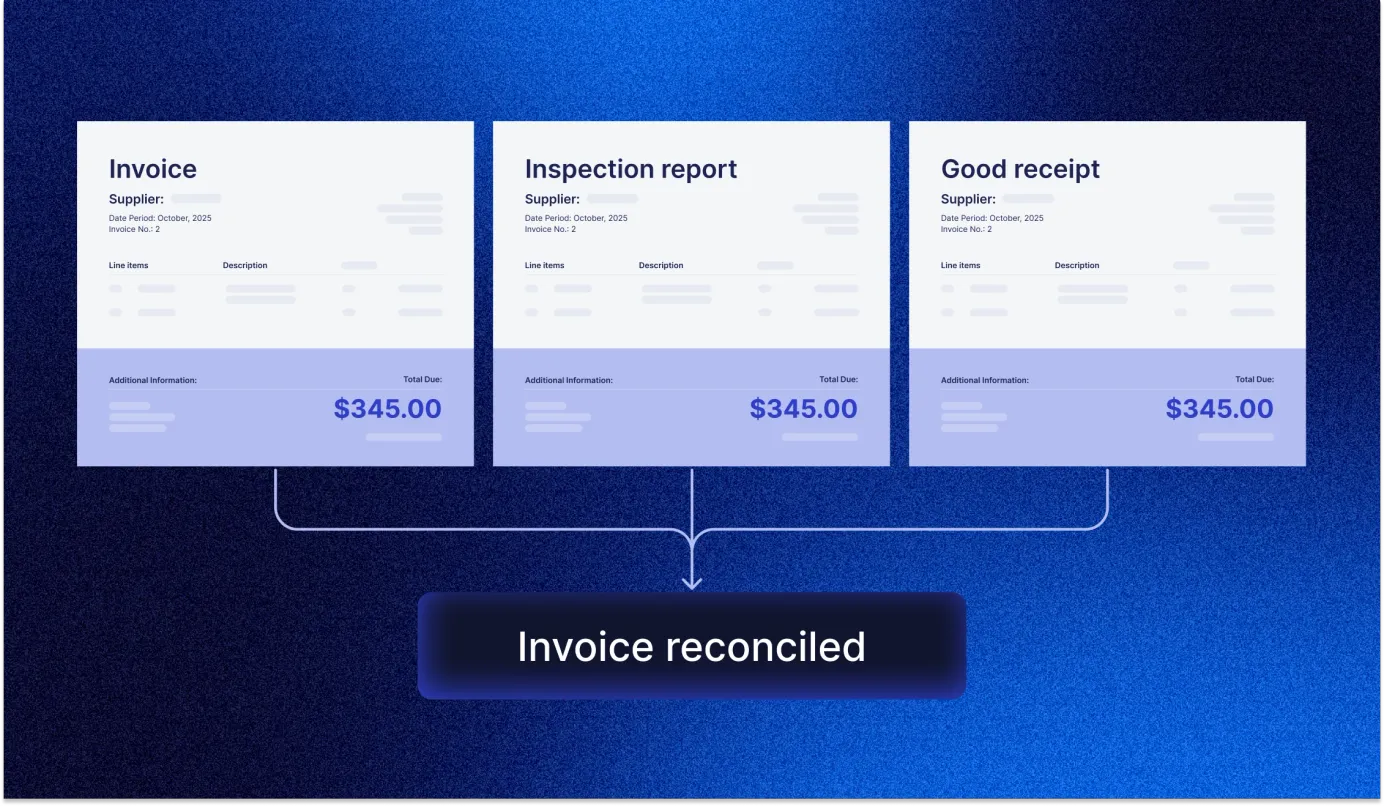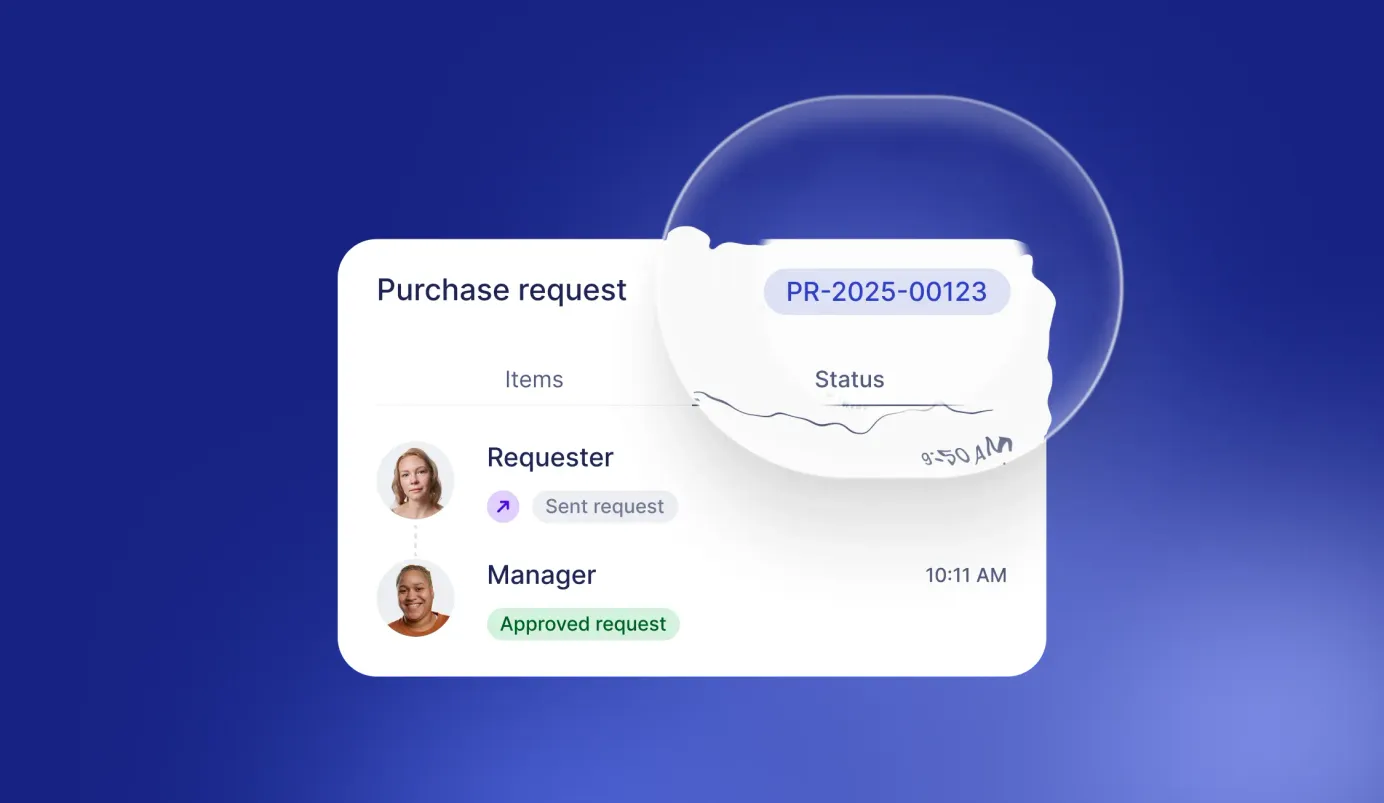
14 min read
Everything You Need to Know About Requisition Numbers in Procurement
Find out how requisition numbers help companies keep their purchase requests clear, traceable, and easy to manage from start to finish.
In procurement, details matter. Ever wondered how companies keep track of hundreds or thousands of purchase requests without losing their minds? The secret’s in the requisition number: a small but important code that keeps every purchase requisition (PR) on track for requesters, approvers, and the procurement team.
Scroll down to find out:
What is a requisition number?
Requisition number meaning vs. PO number meaning
Components of a requisition number
How is a requisition number assigned?
Why is a requisition number important?
Where is the requisition number used in the procurement process?
What problems can happen if requisition numbers aren’t managed well?
How can you manage requisition numbers more effectively?
Frequently asked questions about the requisition number meaning
What is a requisition number?
A requisition number, often called a req number, is a unique identifier assigned to every purchase requisition (the internal request that helps employees initiate the buying process). Essentially, it’s the tracking code for a request.
Just like a shipment has a tracking number that lets you follow it from warehouse to doorstep, a requisition number stays with the request as it moves through the procurement process. It helps stakeholders track a request, links it to the related purchase order, and is often referenced during audits.
Having this unique ID makes it easier to manage large volumes of requests across multiple departments or locations without losing track of who asked for what, when, and why. Requisition numbers are especially important in organizations with formal procurement policies, where purchases must be reviewed and approved before contacting suppliers.
Requisition number meaning vs. PO number meaning
A requisition number is an internal tracking code assigned to a purchase request within your company. It’s created when an employee asks to buy something, but before any official order goes out to a supplier. The req number helps teams manage requests and make sure everything is reviewed and authorized before spending company money.
A purchase order (PO) number is assigned when your company officially places an order with a supplier. The PO is a formal document that confirms what you’re buying, in what quantity, and at what price. The purchase order number identifies this document and is used to communicate with suppliers, track deliveries, and process invoices and payments.
How do they work together?
Think of the requisition number as the “green light” inside your company: it shows that a purchase has been requested and approved. Once approved, the procurement manager turns the request into a purchase order with its own PO number, which then goes to the supplier.
Many companies link the PO back to the req number so they can trace the order back to the original request. This connection helps keep everything transparent and easy to track.
Why aren’t req numbers and PO numbers the same?
Distinct requisition and PO numbers help avoid confusion and keep the process flexible when organizations handle many requests across teams, departments, or suppliers. Here’s why the numbers shouldn’t be the same:
One requisition can lead to multiple POs
For example, someone might submit a single requisition that includes items from three different suppliers. When it’s time to place the orders, the procurement manager creates three separate POs, one per supplier. If you reused the same number for all, it would quickly get messy.
One PO can group multiple requisitions
The procurement team may combine multiple approved requisitions into a single PO for bulk purchasing or planned restocking. This approach helps reduce shipping costs and take advantage of volume discounts. Using separate numbers makes it easier to trace requests back to the people who submitted them.
They serve different audiences
Requisition numbers are mainly for internal use: tracking, approvals, and documentation. PO numbers, on the other hand, go to suppliers and often show up on invoices and delivery notes. Giving each step its own number avoids mix-ups and ensures the right people are looking at the right information.
They play different roles in the audit trail
During audits or budget reviews, you might need to trace how a spending decision was made, from purchase requisition to approval to payment. Separate numbers help create a clean, step-by-step trail showing how a request turned into an actual order and, eventually, an expense.
Components of a requisition number
Now that you know what a requisition number is, let’s see what it includes. A req number usually follows a clear structure designed to provide useful information at a glance. Understanding the components helps everyone quickly identify important details about the request.
Here are the common elements you’ll find in most requisition numbers:
1. Prefix
This is often a short code that indicates the type of document. For example, PR or REQ signals that it’s a purchase requisition. Using a prefix makes it easy to distinguish requisitions from other documents like purchase orders (PO) or invoices.
2. Date or year
Many requisition numbers include the year or date when the request was created, which helps organize and sort requisitions chronologically. For example, 2025 in PR-2025-0045 shows the request was made in 2025.
3. Department or location code
In organizations with multiple departments or locations, adding a code here helps quickly identify where the request came from. For instance, HR for Human Resources or NY for a New York office.
4. Sequential number
This is the unique part that makes each requisition number different. It’s usually a running number that increases with every new request, like 0045 in PR-2025-HR-0045. Sequential numbering helps spot missing requests and keeps everything in order.
5. Optional elements
Some companies add extra information, such as project codes, cost centers, or requester initials, to make the number even more informative and tailored to their needs. For example, the number PR-2025-HR-CC300-JD-0045 means the request came from HR, is tied to cost center 300, and was submitted by someone with the initials JD. Urgent requests can also be marked directly in the number, like PR-2025-HR-URG-0045, so they stand out right away.
Here are a few examples of different req numbers:
- PR-2025-00123—“PR” for Purchase Requisition, followed by the year and a sequential number
- REQ-MKT-045—includes the department (marketing) to show where the request came from
- NY-HR-2025-010—includes location (New York), department (HR), year, and request number
Not every company uses the same req number format. It can vary depending on your system or internal preferences. What really matters is that the format stays consistent, is easy for everyone to understand, and ensures each request has a unique identifier.
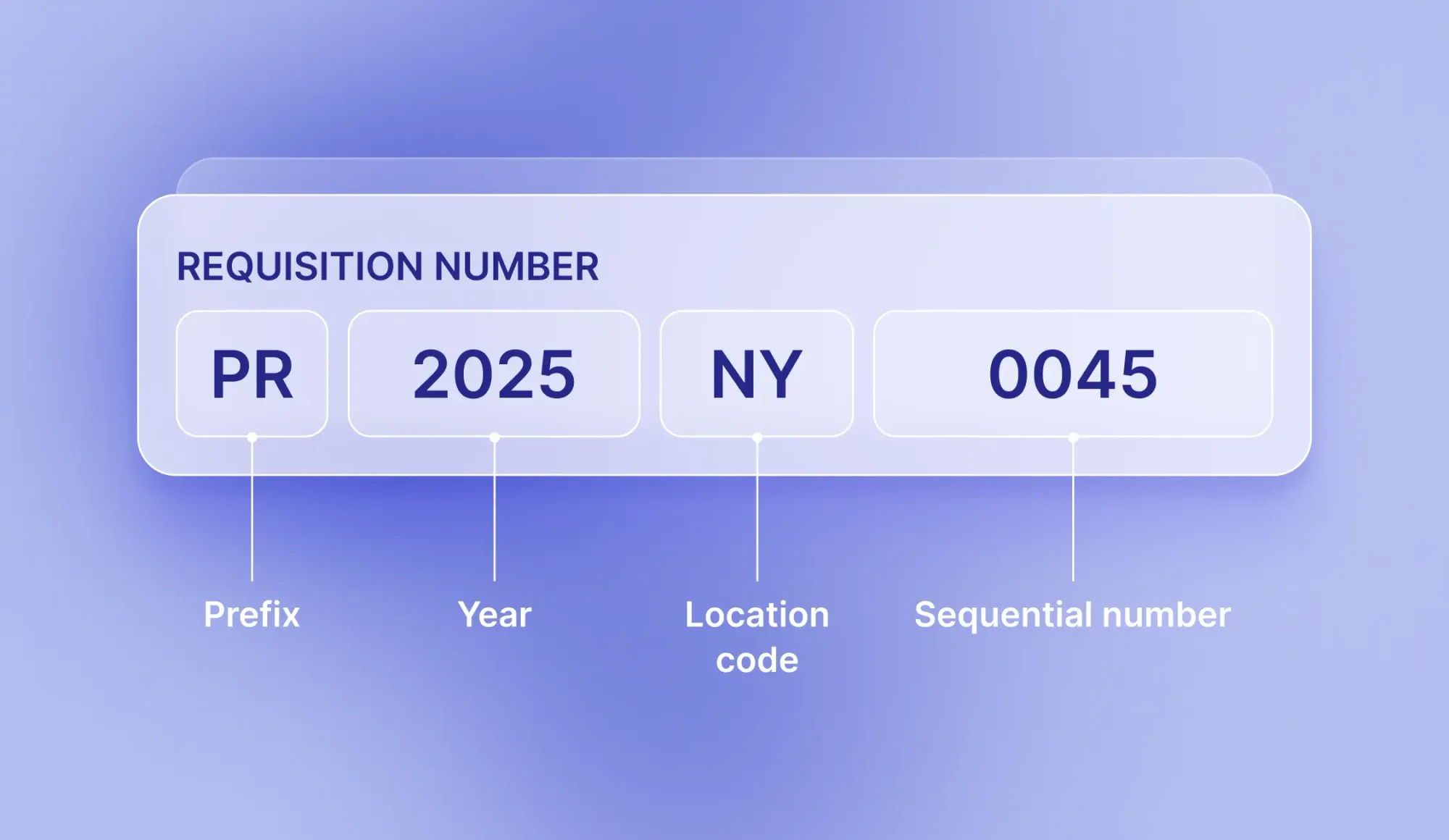
How is a requisition number assigned?
Requisition numbers can be assigned in two main ways: manually or automatically, depending on how your procurement process is set up.
Manual assignment
In smaller teams or companies that don’t use procurement software, requisition numbers are often added manually. Employees usually assign the next number in line and type it into a spreadsheet or write it on a paper form. For example, a requester might label their form REQ-0451, and the next person uses REQ-0452, and so on.
While this approach can work when request volume is low and handled by just a few people, it has some serious limitations as operations scale up. Manual assignment increases the risk of:
- Duplicate numbers, especially if multiple people are submitting requests at the same time.
- Skipped or inconsistent numbers if someone forgets the sequence or uses the wrong format.
- Tracking issues since there’s no automatic link between the related documents. If the number is entered incorrectly or inconsistently, it becomes difficult to trace the request, match it with the right PO or invoice, and maintain a clear audit trail.
Automatic assignment (via procurement software)
These days, most companies use procurement software that automatically generates requisition numbers for every new purchase request. As soon as someone submits a request, the system creates a unique number based on the rules you set up.
As the purchase requisition software does this automatically, you don’t have to worry about duplicates or mistakes. Each number is:
- Unique: no two requests get the same number
- In order: the sequence stays neat and easy to follow
- Consistent: numbers share the same format, so you can understand them at a glance
Moreover, specialized software provides complete visibility into all requests, orders, and invoices. In fact, 54% of procurement professionals say that real-time data access leads to better decisions.
Why is a requisition number important?
A req number isn’t just a formality. Every time someone in your company asks to buy something, that request needs to be carefully tracked. The requisition number gives each request a unique identity that stays with it throughout the procurement process.
Here’s why understanding a requisition number definition and using these numbers matter so much:
It keeps things organized
When your company handles dozens, hundreds, or even thousands of purchase requests from different teams, departments, or locations, things can quickly get overwhelming. A clear, consistent numbering system makes it easy to find, sort, and manage all those requests without confusion or mix-ups.
It supports faster approvals and clear accountability
Approvers, finance teams, and procurement staff use requisition numbers to quickly identify what they’re reviewing. They can easily check who submitted the request, what it’s for, and whether it’s already been handled. This clarity helps speed up approvals and keeps everyone accountable.
It enables better reporting and audit trails
Want to know how many requests came from the sales team last quarter? Or identify which purchases went over budget? Req numbers make it easy to create accurate reports and analyze demand. They’re also essential for audits, compliance checks, and internal reviews to keep your company transparent and accountable.
Where is the requisition number used in the procurement process?
The requisition number is mainly used on the internal side of the procurement process. It helps keep purchase requests organized, traceable, and easy to reference, especially in companies that process many requests across different teams or locations.
When someone submits a purchase request, the system (or a requester) assigns a unique req number. That number is then used during the approval process and helps managers and finance teams quickly identify what’s being requested, who submitted it, and which department or budget it falls under.
After the purchase requisition is approved, a purchase order is usually created based on its details. While the PO becomes the main document for supplier communication, it may still reference the requisition number to keep the request linked to the order.
In day-to-day operations, the requisition number is less relevant after the PO is issued, especially when it comes to invoice matching, which typically relies on the PO number. That said, keeping the request number in your records helps with internal tracking and makes the purchase’s original intent easier to understand. Plus, it provides additional context if you ever need to look back at the full request history.
Requisition numbers also come in handy for internal reporting and audits. They allow procurement or finance teams to trace who submitted what, when, and why—even before any official orders were placed.
In short, while suppliers or payment systems don’t depend on a requisition number, it plays a helpful internal role in keeping purchase requests visible, traceable, and easier to manage.
What problems can happen if requisition numbers aren’t managed well?
It might seem like a small detail, but when requisition numbers aren’t managed properly, the whole procurement process can start to unravel. A weak or inconsistent numbering system can cause confusion, delays, and even financial risk.
Here’s what can go wrong:
Duplicate or missing numbers
If two requests end up sharing the same number, telling them apart proves tricky. On the other hand, if a number is skipped or lost, it raises questions: Was there a missing request? Was something deleted? This lack of clarity can slow down approvals, confuse stakeholders, and cause unnecessary back-and-forth between departments.
Lost requests and missed approvals
Without a structured numbering system, requisitions can easily go missing (especially in manual or email-based processes). A request might sit unapproved for weeks or, worse, get forgotten entirely. As a result, companies may face urgent last-minute orders, stockouts, or delays in critical operations.
Broken links between documents
In a well-run procurement process, the requisition number helps tie the original request to the PO, invoice, and payment. However, when the numbering is inconsistent (or missing altogether), it becomes hard to match up documents. You end up wasting time trying to trace records manually or chasing people for clarification.
Audit and compliance risks
Regulatory audits and internal controls often require clear documentation showing who requested a purchase, who approved it, and how it moved through the system. If your requisition numbering is messy or unreliable, it’s difficult to prove that proper steps were followed, and that can raise red flags during an audit.
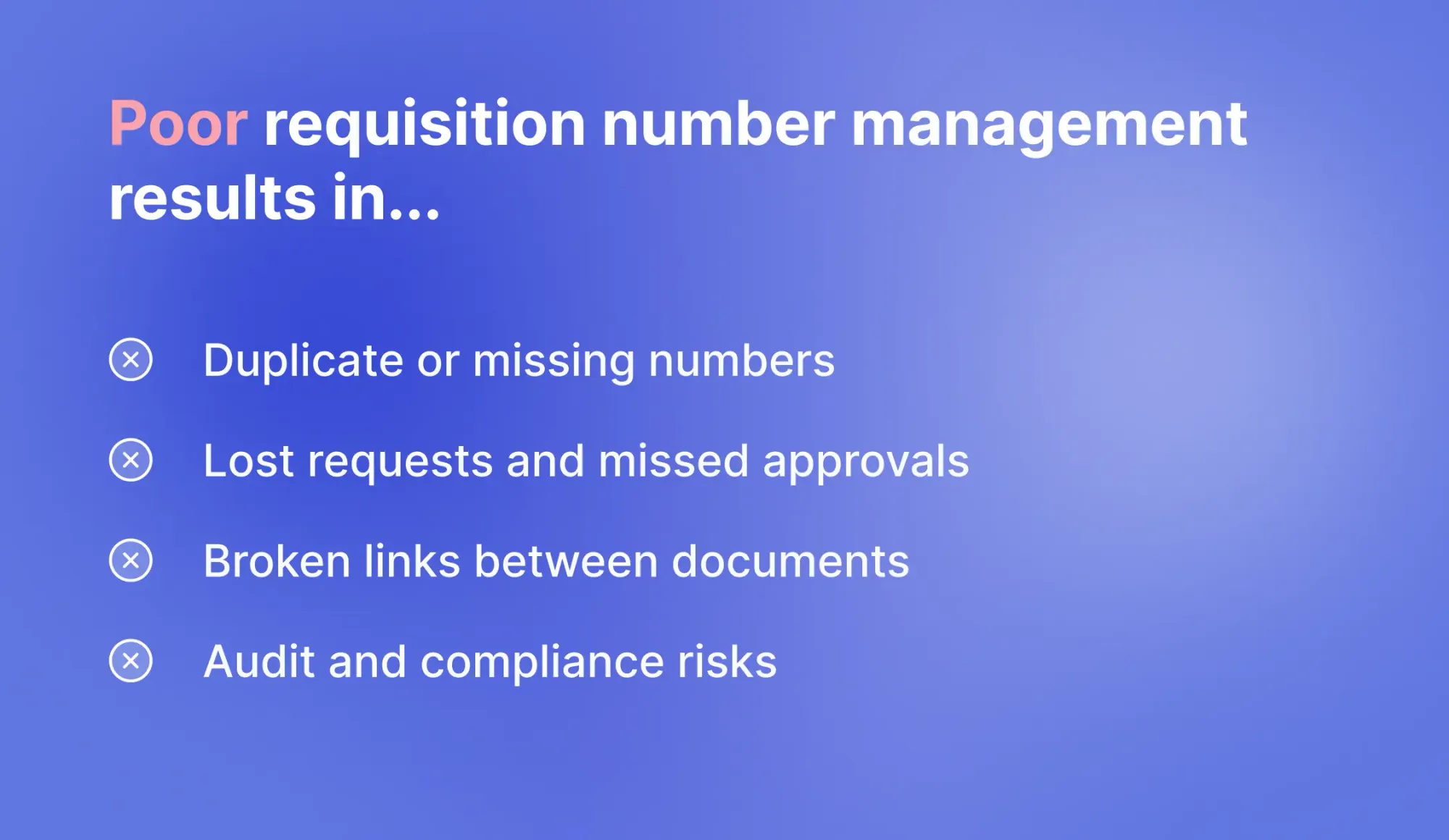
How can you manage requisition numbers more effectively?
Managing requisition numbers well is all about consistency, automation, and clear rules. Here’s how you can improve the process and avoid common headaches:
Automate the numbering system whenever possible
Manual tracking works only for very small teams, and even for them, it’s risky. Using procurement software that automatically generates requisition numbers takes the guesswork (and error) out of the process.
A procurement system, like Precoro, assigns each new request a unique, sequential number based on pre-set rules, so you don’t have to worry about duplicates, skipped entries, or inconsistent formatting. Procurement automation also saves time for employees and keeps the data cleaner for reporting and audits. It’s no surprise that 83% of global CPOs prioritize procurement digitization.

Standardize your numbering format
A consistent format makes requisition numbers easier to understand at a glance. Decide on a clear structure that reflects your internal needs.
Including things like document type (PR), year, department or location code, and a sequential ID helps you sort and filter requisitions easily across teams or time periods. For example, PR-2025-MKT-0042 means that the marketing team submitted a purchase requisition in 2025, and it was their 42nd request that year.
Just make sure everyone sticks to the same structure. Even the best system falls apart without good habits. Provide simple guidelines for requesters on how req numbers are structured, where to find them, and how they’re used in approvals and purchasing.
Reserve number blocks for different entities or departments
If different business units use the same pool of requisition numbers, things can quickly get messy. You can avoid confusion by giving each group its own block of numbers to use. For example, North America could use 10000–19999, EMEA 20000–29999, and so on.
This way, no two teams accidentally use the same number, and everyone can work independently without stepping on each other’s toes. It also makes reporting and audits easier since you can tell where a request came from just by looking at the number. Split the number ranges however it makes sense, but make sure to leave some extra space in each range in case one group grows or submits a lot more requests over time.
Make requisition numbers visible and searchable
Don’t bury the req number in a spreadsheet tab or internal system where only one team can see it. Make sure the number appears clearly in the request form, approval workflows, PO creation, and internal dashboards.
This approach makes collaboration smoother: requesters, approvers, and finance teams can all reference the same number and stay aligned. Bonus points if your purchase requisition system lets you search or filter requests by number.
Use requisition numbers to improve forecasting and planning
A consistent numbering system helps you analyze purchasing trends over time. For example, you might notice that the facilities team submits a high volume of requisitions every spring for office maintenance, equipment upgrades, or renovation projects. Maybe you spot a pattern: the IT department ramps up requests in Q4 for year-end upgrades. Knowing this in advance allows you to prepare vendor capacity, negotiate better pricing for bulk needs, and allocate budget more accurately.
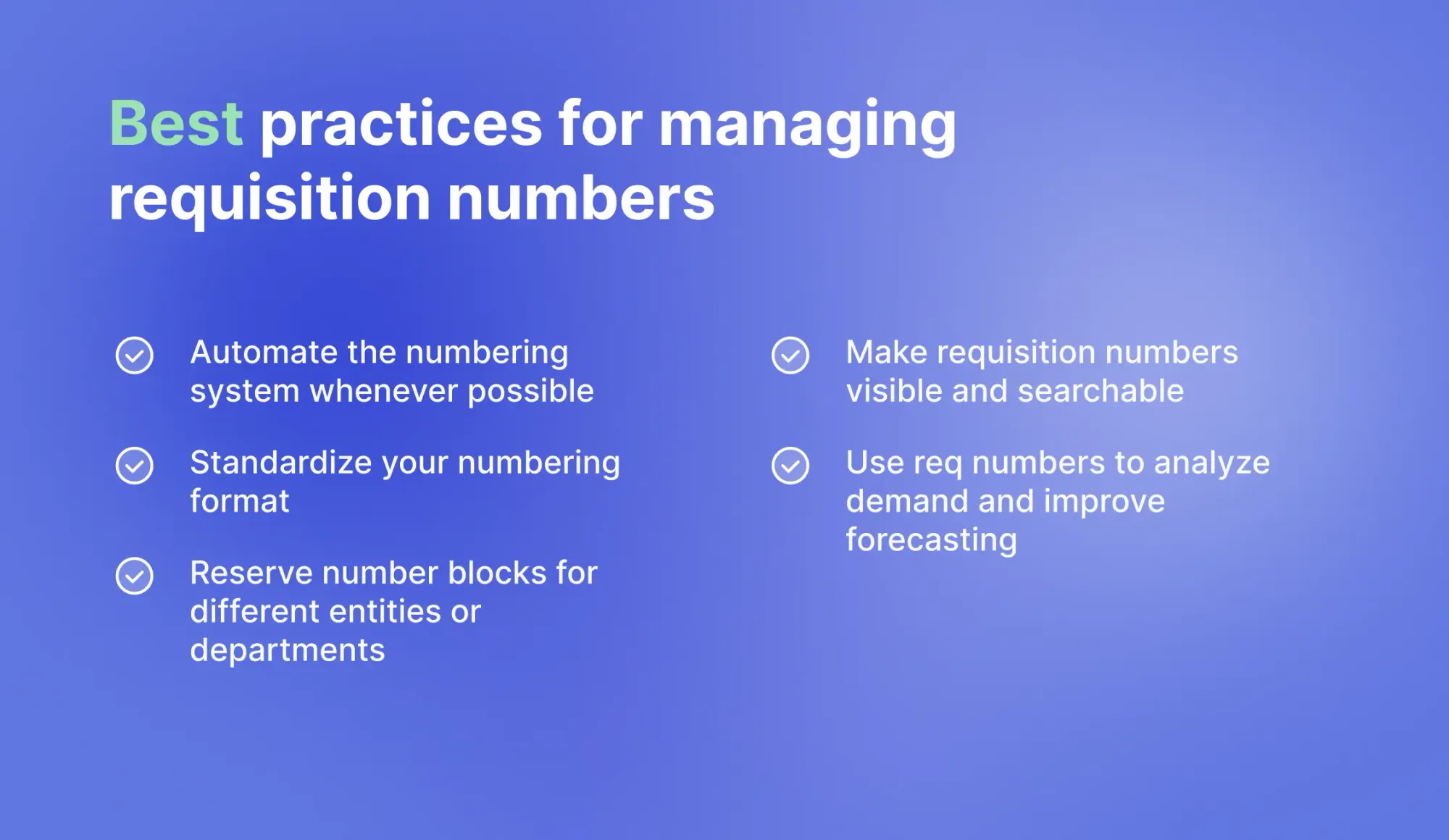
Frequently asked questions about the requisition number meaning
A requisition number is a unique ID assigned to a purchase request inside your company. It helps track that specific request as it moves through approvals and becomes an actual order.
The requisition number is the internal reference for a request to buy something. It stays inside your organization throughout the approval process. A purchase order number appears on the official document sent to the supplier. It helps track the order and ensure accurate processing and payment.
Yes, a single requisition can cover multiple items and even different vendors if they’re part of the same purchase need. However, if the purchases serve different purposes or fall under separate budgets, it’s better to create separate requisitions for clarity.
Usually, no. Requisition numbers are internal codes used to track purchase requests within a company. Instead, suppliers mainly deal with purchase order numbers, which formalize the order. In some large or complex projects, companies might share the requisition number with vendors to help link the delivery or invoice to the original internal request. However, this practice is less common and depends on the company’s processes.
Final thoughts: Why should you care about what a req number is?
A requisition number definition is more than just a string of digits: it’s a unique code that helps companies stay on top of all their requests. A req number is the key to tracking what someone inside your company wants to buy, why they need it, and whether that request gets approved.
If you still assign requisition numbers by hand, you risk running into duplicate or missing numbers, delayed approvals, or even lost requests. Automating this step with procurement software helps a lot: it guarantees every request gets a unique, sequential number right away, with no errors. What’s more, you can track purchase requisitions and related documents directly in the system.
Good requisition number management also makes reporting easier, helps you spot purchasing trends, speeds up audits, and supports procurement compliance. Treat requisition numbers as a helpful tool, not just a formality, and you’ll build a purchasing process that’s both clear and reliable.



